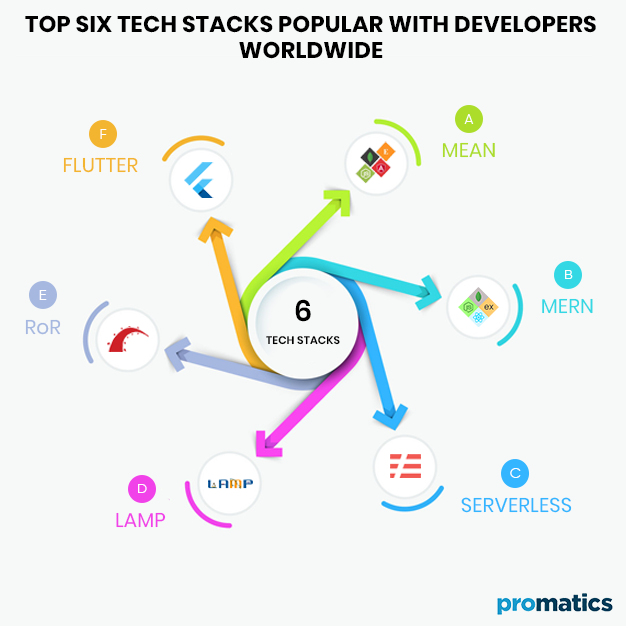The Most Popular Tech Stacks of 2021 as per Developers
When it comes to a developer, he/she is more concerned about how a piece of software such as a website or a mobile application is built than he is concerned about its final presentation. The thousands of commands and lines of code that run to execute a single feature are not as simple as writing a word document. There are multiple levels of development including the frontend, the backend, and the UX design. These different tools come together to form a tech stack.
What is a tech stack?
The list of programming languages, software tools, and development frameworks that are used to construct any software product (a website, computer software, a game, or a mobile application) is collectively referred to as a tech stack.
Why tech stacks matter?
Tech stacks form the blood in any application. Just like a doctor is concerned about a patient’s blood before any critical medical treatment, similarly, a developer needs to know about the tech stack of any software before he can make any improvements to it or develop an adjoining product that works with a particular application.
Say, a developer wants to get hired in a software company that uses Java and PHP for its products. The developer does not know how to code in either of the two languages (though it is highly unlikely that you will find such a developer). In such a case, it is more or less impossible that he gets a job in the company and even if he does get the job somehow, he will find it extremely difficult to settle in. He would have to learn both the new languages so that he can put his expertise to practical use.
On the other hand, we have a girl who knows Python and wants to become an AI developer. Now Python is a very popular language that is on the rise when we talk about AI and so, instead of starting from zero, she will start from the most advanced concepts about AI development.
This was from a developer’s perspective.
From a company’s point of view, the tech stack greatly impacts the development of its products. Considering aspects like the number of resources available for a particular language, the skill level of available human resources, how the languages and frameworks will come together and the after-launch bug-removal process becomes very important so choosing a tech stack is a very critical decision before you start on computer software or a mobile application.
What are the top 6 tech stacks to consider in 2021?
When we are talking about a tech stack, we are generally referring to the frontend, backend, and database being used. The frontend and backend, both, can individually be further divided into two components:
- Language
- Framework
As you probably know, the frontend is the consumer’s side of the software while the backend is the server-side that communicates with the database to perform the particular operation for the client.
We will discuss the different popular tech stacks that are most likely to shine in the limelight during 2021 and in the upcoming years so you can better decide about which languages and frameworks you should be learning as a developer and what should you decide for your upcoming app that you are thinking to develop.
1. MEAN
Java has been the most popular platform in the tech development industry for the last 2 decades and MEAN is a true representative of Java.
MEAN comprises of the following four components:
a.) MongoDB as its database
b.) The frontend framework of Angular.js
c.) The backend framework of Express.js
d.) NodeJS cross-platform server
The topmost important thing about MEAN is that this stack completely revolves around Java and all four components speak JavaScript Object Notations JSON.
Why use MEAN?
MEAN offers a number of useful conveniences that make it a particularly useful option for a company and a developer.
i.) Java has been around for a long time now and you can find abundant skillful resources in the market very easily.
ii.) The laborious tasks of duplicating the code and then changing it to work with another language can be avoided. MEAN stack is completely JSON and there is no need to translate code lines every now and then. Simply copy, paste and modify it to your use.
iii.) The MEAN tech stack is completely open-source and is free to use. The bundle is backed by a very strong and experienced community that comprises seasoned as well as innovative minds that can make breakthroughs easily.
So, using MEAN you not only get an environment of the most abundantly used languages, you also have the support of an extensive community in the hour of need.
2. MERN
Should I save your time to explain what is MERN, it is the same as MEAN with one difference. MERN uses React instead of Angular.js as its frontend framework. So the complete tech sack looks something like this:
a.) MongoDB as the database
b.) js as the backend development framework
c.) React library for building user interfaces
d.) js built on Chrome’s V8 that handles the server
Once again, only two languages come into play; Javascript and JSON that deal with everything starting from the server to the client and back.
Why use MERN?
MERN offers almost all of the advantages that we already talked about in MEAN. Often MERN and MEAN are pitted against each other.
i.) You get the support of an extensive and highly skilled community that can help you get out of a fix in no time.
ii.) The four technologies are highly compatible with each other and help you in bringing down costs because now you need an expert in Javascript and not a colorful bunch of PHP, Python, Ruby on Rails, and Rust.
iii.) React brings with it the opportunity of a full-stack. React is a very simple and fast library that makes user design development very convenient.
However, there is one drawback to it. Express.js, which React replaced in MERN, is a full-fledged framework while React is a library. You may come across certain crossroads where you might find yourself out of options. Nonetheless, your extended family will help you get out of it in no time.
3. Serverless
Serverless is our rising star of the industry that promotes a new type of development. Serverless development, just like the word describes, promotes a new idea. IT revolves around the idea that you do not need to keep your own server or make any special arrangements.
Giants like Amazon Web Services (AWS) or Google are offering their services. Take Amazon, for instance, you can use Amazon Lambda and Amazon EventBridge for the development and use Amazon DynamoDB as the database to securely store your information online.
Why Serverless?
i.) The major benefit when it comes to Serverless is growth. You do not have any limits to growth because the plans are designed to your needs. You pay for the resources you use and do not have unnecessary shortages or unused resources.
ii.) You get to use the best of the processors and storage that are available in the market. In the initial stages of your website or app, you may not be able to deploy costly resources like TPUs and SSDs on your own but you can sure use the ones at Amazon or Google if you choose to go Serverless.
4. LAMP
LAMP can be regarded as the most conventional tech stack out there. It comprises the following components:
a.) Linux
b.) Apache as the server
c.) MySQL as the database
d.) PHP as the backend language
The funny thing about this tech stack is that you can swap things and modify them to your needs.
i.) You can change Linux with Windows can make it WAMP or if you are working with MacOS, you can even make it MAMP.
ii.) You can swap the PHP with Pearl or the increasingly popular Python (that is built around C++ and is very fast and adaptive, has an extensive library, a rich framework is very easy to learn and use)
Why use LAMP?
The benefits of using LAMP include the following:
1.) LAMP is the most tried and tested tech stack of the 21st It has years of experience squeezed into it and you will hardly come across a development problem in LAMP that does not have a solution.
2.) LAMP is an open-source set of tools that are completely free to use and have a seasoned community of developers.
3.) The tech stack is very agile and works particularly well with dynamic webpages that need to be refreshed every now and then.
When something has lived for as long as LAMP, they are highly compatible with a vast variety of platforms because, after such a duration, they do not follow the industry. They define the industry standard. So is the case here that LAMP has become the industry preference and things like WordPress that more powers more than 50% of the internet are constructed on it.
5. RoR
Roby on Rails (also called Rails or RoR) is another web development framework that is popular for a few years now. Ruby of Rails was first developed as a side-project to Basecamp and eventually, Basecamp was the first thing that demonstrated Ruby of Rails in 2003. However, it is now that we have seen such a rise in its fame.
Why use Ruby on Rails?
The most important thing for developers is the set of libraries that are available.
You can define the library as a set of developed functions that have been summarized into a shortcut to simply call the commands that the shortcut hides.
These libraries make development very easy because instead of writing everything from scratch, you can benefit from the works of other developers who have published their works online. These libraries make the development process extremely time-efficient.
6. Flutter
Last but not the least, our young candidate is Flutter that is highly optimized for app development on both Android and iOS platforms. Flutter is a relatively new option in the market that has the capacity to completely change the process of app development.
It uses Dart as the development language and can be easily used in IntelliJ, Visual Code Studio or Android Studio.
Why use Flutter?
Should you opt to choose Flutter, these are the advantages that you can take:
a.) An app developed in Flutter is equally good for both Android and iOS and consequently, you have to put less effort into the development and testing.
b.) The performance of an app developed in Flutter is very efficient because the stack as incorporated in itself all of the shortcomings that we face in our tech stacks such as MERN or LAMP.
However, you may come across one problem that being a new language, Flutter has a very limited library of libraries and you may have to construct functions from scratch all by yourself.
Still, Flutter has a very bright future in years to come and if you are being positive about the forecast, early adoption of Flutter in your app may turn out to be your best decision for the future.
Final Word…
The takeaway from our discussion is that all tech stacks have their own benefits. Some are old but mature while others are relatively new but equally efficient in their performance. The final decision should be made while considering the facts and figures of your human and technological resources and which one allows you to make the optimal usage of your resources.
Still have your concerns?
Your concerns are legit, and we know how to deal with them. Hook us up for a discussion, no strings attached, and we will show how we can add value to your operations!

